LinearDiscriminantAnalysis#
- class sklearn.discriminant_analysis.LinearDiscriminantAnalysis(solver='svd', shrinkage=None, priors=None, n_components=None, store_covariance=False, tol=0.0001, covariance_estimator=None)[source]#
Linear Discriminant Analysis.
A classifier with a linear decision boundary, generated by fitting class conditional densities to the data and using Bayes’ rule.
The model fits a Gaussian density to each class, assuming that all classes share the same covariance matrix.
The fitted model can also be used to reduce the dimensionality of the input by projecting it to the most discriminative directions, using the
transformmethod.Added in version 0.17.
For a comparison between
LinearDiscriminantAnalysisandQuadraticDiscriminantAnalysis, see Linear and Quadratic Discriminant Analysis with covariance ellipsoid.Read more in the User Guide.
- Parameters:
- solver{‘svd’, ‘lsqr’, ‘eigen’}, default=’svd’
- Solver to use, possible values:
‘svd’: Singular value decomposition (default). Does not compute the covariance matrix, therefore this solver is recommended for data with a large number of features.
‘lsqr’: Least squares solution. Can be combined with shrinkage or custom covariance estimator.
‘eigen’: Eigenvalue decomposition. Can be combined with shrinkage or custom covariance estimator.
Changed in version 1.2:
solver="svd"now has experimental Array API support. See the Array API User Guide for more details.- shrinkage‘auto’ or float, default=None
- Shrinkage parameter, possible values:
None: no shrinkage (default).
‘auto’: automatic shrinkage using the Ledoit-Wolf lemma.
float between 0 and 1: fixed shrinkage parameter.
This should be left to None if
covariance_estimatoris used. Note that shrinkage works only with ‘lsqr’ and ‘eigen’ solvers.For a usage example, see Normal, Ledoit-Wolf and OAS Linear Discriminant Analysis for classification.
- priorsarray-like of shape (n_classes,), default=None
The class prior probabilities. By default, the class proportions are inferred from the training data.
- n_componentsint, default=None
Number of components (<= min(n_classes - 1, n_features)) for dimensionality reduction. If None, will be set to min(n_classes - 1, n_features). This parameter only affects the
transformmethod.For a usage example, see Comparison of LDA and PCA 2D projection of Iris dataset.
- store_covariancebool, default=False
If True, explicitly compute the weighted within-class covariance matrix when solver is ‘svd’. The matrix is always computed and stored for the other solvers.
Added in version 0.17.
- tolfloat, default=1.0e-4
Absolute threshold for a singular value of X to be considered significant, used to estimate the rank of X. Dimensions whose singular values are non-significant are discarded. Only used if solver is ‘svd’.
Added in version 0.17.
- covariance_estimatorcovariance estimator, default=None
If not None,
covariance_estimatoris used to estimate the covariance matrices instead of relying on the empirical covariance estimator (with potential shrinkage). The object should have a fit method and acovariance_attribute like the estimators insklearn.covariance. if None the shrinkage parameter drives the estimate.This should be left to None if
shrinkageis used. Note thatcovariance_estimatorworks only with ‘lsqr’ and ‘eigen’ solvers.Added in version 0.24.
- Attributes:
- coef_ndarray of shape (n_features,) or (n_classes, n_features)
Weight vector(s).
- intercept_ndarray of shape (n_classes,)
Intercept term.
- covariance_array-like of shape (n_features, n_features)
Weighted within-class covariance matrix. It corresponds to
sum_k prior_k * C_kwhereC_kis the covariance matrix of the samples in classk. TheC_kare estimated using the (potentially shrunk) biased estimator of covariance. If solver is ‘svd’, only exists whenstore_covarianceis True.- explained_variance_ratio_ndarray of shape (n_components,)
Percentage of variance explained by each of the selected components. If
n_componentsis not set then all components are stored and the sum of explained variances is equal to 1.0. Only available when eigen or svd solver is used.- means_array-like of shape (n_classes, n_features)
Class-wise means.
- priors_array-like of shape (n_classes,)
Class priors (sum to 1).
- scalings_array-like of shape (rank, n_classes - 1)
Scaling of the features in the space spanned by the class centroids. Only available for ‘svd’ and ‘eigen’ solvers.
- xbar_array-like of shape (n_features,)
Overall mean. Only present if solver is ‘svd’.
- classes_array-like of shape (n_classes,)
Unique class labels.
- n_features_in_int
Number of features seen during fit.
Added in version 0.24.
- feature_names_in_ndarray of shape (
n_features_in_,) Names of features seen during fit. Defined only when
Xhas feature names that are all strings.Added in version 1.0.
See also
QuadraticDiscriminantAnalysisQuadratic Discriminant Analysis.
Examples
>>> import numpy as np >>> from sklearn.discriminant_analysis import LinearDiscriminantAnalysis >>> X = np.array([[-1, -1], [-2, -1], [-3, -2], [1, 1], [2, 1], [3, 2]]) >>> y = np.array([1, 1, 1, 2, 2, 2]) >>> clf = LinearDiscriminantAnalysis() >>> clf.fit(X, y) LinearDiscriminantAnalysis() >>> print(clf.predict([[-0.8, -1]])) [1]
- decision_function(X)[source]#
Apply decision function to an array of samples.
The decision function is equal (up to a constant factor) to the log-posterior of the model, i.e.
log p(y = k | x). In a binary classification setting this instead corresponds to the differencelog p(y = 1 | x) - log p(y = 0 | x). See Mathematical formulation of the LDA and QDA classifiers.- Parameters:
- Xarray-like of shape (n_samples, n_features)
Array of samples (test vectors).
- Returns:
- Cndarray of shape (n_samples,) or (n_samples, n_classes)
Decision function values related to each class, per sample. In the two-class case, the shape is (n_samples,), giving the log likelihood ratio of the positive class.
- fit(X, y)[source]#
Fit the Linear Discriminant Analysis model.
Changed in version 0.19: store_covariance has been moved to main constructor.
Changed in version 0.19: tol has been moved to main constructor.
- Parameters:
- Xarray-like of shape (n_samples, n_features)
Training data.
- yarray-like of shape (n_samples,)
Target values.
- Returns:
- selfobject
Fitted estimator.
- fit_transform(X, y=None, **fit_params)[source]#
Fit to data, then transform it.
Fits transformer to
Xandywith optional parametersfit_paramsand returns a transformed version ofX.- Parameters:
- Xarray-like of shape (n_samples, n_features)
Input samples.
- yarray-like of shape (n_samples,) or (n_samples, n_outputs), default=None
Target values (None for unsupervised transformations).
- **fit_paramsdict
Additional fit parameters.
- Returns:
- X_newndarray array of shape (n_samples, n_features_new)
Transformed array.
- get_feature_names_out(input_features=None)[source]#
Get output feature names for transformation.
The feature names out will prefixed by the lowercased class name. For example, if the transformer outputs 3 features, then the feature names out are:
["class_name0", "class_name1", "class_name2"].- Parameters:
- input_featuresarray-like of str or None, default=None
Only used to validate feature names with the names seen in
fit.
- Returns:
- feature_names_outndarray of str objects
Transformed feature names.
- get_metadata_routing()[source]#
Get metadata routing of this object.
Please check User Guide on how the routing mechanism works.
- Returns:
- routingMetadataRequest
A
MetadataRequestencapsulating routing information.
- get_params(deep=True)[source]#
Get parameters for this estimator.
- Parameters:
- deepbool, default=True
If True, will return the parameters for this estimator and contained subobjects that are estimators.
- Returns:
- paramsdict
Parameter names mapped to their values.
- predict(X)[source]#
Predict class labels for samples in X.
- Parameters:
- X{array-like, sparse matrix} of shape (n_samples, n_features)
The data matrix for which we want to get the predictions.
- Returns:
- y_predndarray of shape (n_samples,)
Vector containing the class labels for each sample.
- predict_log_proba(X)[source]#
Estimate log probability.
- Parameters:
- Xarray-like of shape (n_samples, n_features)
Input data.
- Returns:
- Cndarray of shape (n_samples, n_classes)
Estimated log probabilities.
- predict_proba(X)[source]#
Estimate probability.
- Parameters:
- Xarray-like of shape (n_samples, n_features)
Input data.
- Returns:
- Cndarray of shape (n_samples, n_classes)
Estimated probabilities.
- score(X, y, sample_weight=None)[source]#
Return the mean accuracy on the given test data and labels.
In multi-label classification, this is the subset accuracy which is a harsh metric since you require for each sample that each label set be correctly predicted.
- Parameters:
- Xarray-like of shape (n_samples, n_features)
Test samples.
- yarray-like of shape (n_samples,) or (n_samples, n_outputs)
True labels for
X.- sample_weightarray-like of shape (n_samples,), default=None
Sample weights.
- Returns:
- scorefloat
Mean accuracy of
self.predict(X)w.r.t.y.
- set_output(*, transform=None)[source]#
Set output container.
See Introducing the set_output API for an example on how to use the API.
- Parameters:
- transform{“default”, “pandas”, “polars”}, default=None
Configure output of
transformandfit_transform."default": Default output format of a transformer"pandas": DataFrame output"polars": Polars outputNone: Transform configuration is unchanged
Added in version 1.4:
"polars"option was added.
- Returns:
- selfestimator instance
Estimator instance.
- set_params(**params)[source]#
Set the parameters of this estimator.
The method works on simple estimators as well as on nested objects (such as
Pipeline). The latter have parameters of the form<component>__<parameter>so that it’s possible to update each component of a nested object.- Parameters:
- **paramsdict
Estimator parameters.
- Returns:
- selfestimator instance
Estimator instance.
- set_score_request(*, sample_weight: bool | None | str = '$UNCHANGED$') LinearDiscriminantAnalysis[source]#
Request metadata passed to the
scoremethod.Note that this method is only relevant if
enable_metadata_routing=True(seesklearn.set_config). Please see User Guide on how the routing mechanism works.The options for each parameter are:
True: metadata is requested, and passed toscoreif provided. The request is ignored if metadata is not provided.False: metadata is not requested and the meta-estimator will not pass it toscore.None: metadata is not requested, and the meta-estimator will raise an error if the user provides it.str: metadata should be passed to the meta-estimator with this given alias instead of the original name.
The default (
sklearn.utils.metadata_routing.UNCHANGED) retains the existing request. This allows you to change the request for some parameters and not others.Added in version 1.3.
Note
This method is only relevant if this estimator is used as a sub-estimator of a meta-estimator, e.g. used inside a
Pipeline. Otherwise it has no effect.- Parameters:
- sample_weightstr, True, False, or None, default=sklearn.utils.metadata_routing.UNCHANGED
Metadata routing for
sample_weightparameter inscore.
- Returns:
- selfobject
The updated object.
- transform(X)[source]#
Project data to maximize class separation.
- Parameters:
- Xarray-like of shape (n_samples, n_features)
Input data.
- Returns:
- X_newndarray of shape (n_samples, n_components) or (n_samples, min(rank, n_components))
Transformed data. In the case of the ‘svd’ solver, the shape is (n_samples, min(rank, n_components)).
Gallery examples#
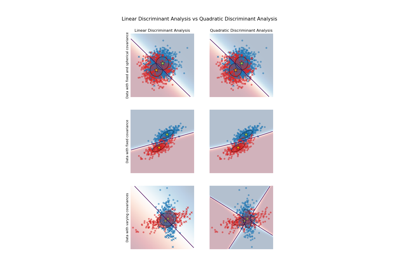
Linear and Quadratic Discriminant Analysis with covariance ellipsoid
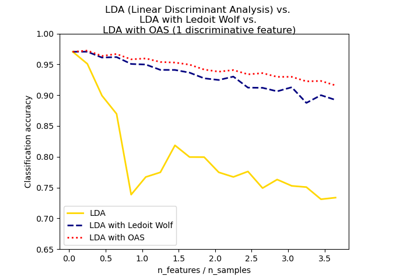
Normal, Ledoit-Wolf and OAS Linear Discriminant Analysis for classification
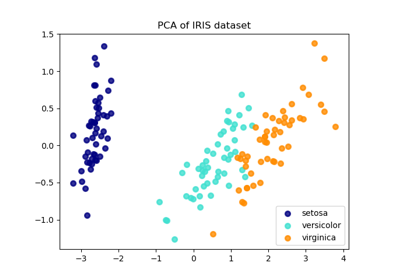
Comparison of LDA and PCA 2D projection of Iris dataset
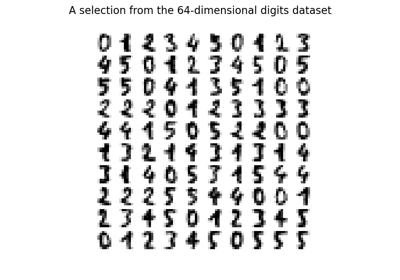
Manifold learning on handwritten digits: Locally Linear Embedding, Isomap…
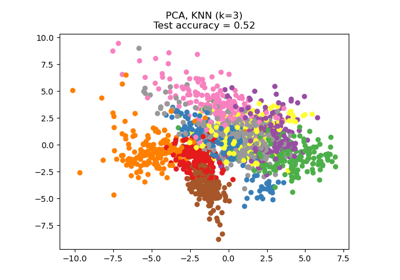
Dimensionality Reduction with Neighborhood Components Analysis
